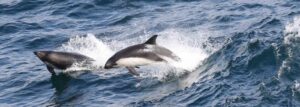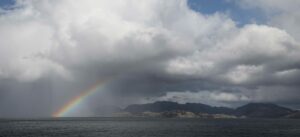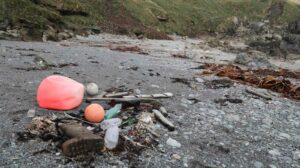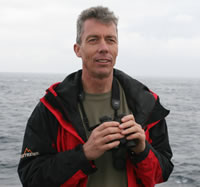By Peter Ryan, onboard scientist, expert in general ornithology, seabird-fishery interactions, evolutionary ecology, marine debris, solid waste management, biology of oceanic islands.
Leg 2, Peter the First to Diego Ramirez and Punta Arenas
The transit from Peter the First to Diego Ramirez took place well offshore from the west coast of the Antarctic Peninsula and lasted three days. Once again the weather was kind and we cruised through mostly calm seas, aiding observations of cetaceans, seals and penguins in the largely ice-free waters. Even the Drake Passage failed to live up to its fearsome reputation. We passed Diego Ramirez around lunchtime on 19 February, and continued on to rendezvous with our Chilean pilots at Cape Horn. In the event the sea was too rough for them, and we had to continue past Cape Horn almost to Puerto Williams, only meeting them at sunset.

Prior to reaching the South American shelf edge, birds were relatively scarce, but a good diversity was recorded in more than 1000 km of transects, dominated by Antarctic Prions and Blue Petrels, although Blues were mainly recorded on February 16th, and prions on the 17th. Chinstrap Penguins were seen in good numbers for the first time on the trip, mixed in with a few Adélie Penguins. Marine mammals also were well represented, with 10 species:
| Antarctic Prion | 162 | Blue Petrel | 86 |
| Chinstrap Penguin | 74 | Cape (Pintado) Petrel | 66 |
| Black-browed Albatross | 61 | Grey-headed Albatross | 56 |
| Soft-plumaged Petrel | 53 | White-chinned Petrel | 42 |
| Wilson’s Storm Petrel | 37 | Antarctic Fulmar | 28 |
| Pygoscelid penguin spp. | 28 | Black-bellied Storm Petrel | 17 |
| Adelie Penguin | 11 | Slender-billed Prion | 11 |
| Southern Giant Petrel | 8 | Sooty Shearwater | 7 |
| Mottled Petrel | 6 | Light-mantled Albatross | 5 |
| Northern Giant Petrel | 4 | Southern Royal Albatross | 3 |
| Wandering Albatross | 3 | South Georgian Diving Petrel | 3 |
| Long-finned Pilot Whale | 62 | Antarctic Fur Seal | 27 |
| Fin Whale | 16 | Hump-backed Whale | 10 |
| Hourglass Dolphin | 10 | Killer Whale | 8 |
| Crabeater Seal | 2 | Antarctic Minke Whale | 2 |
| Dwarf Minke Whale | 2 | Bottlenosed? Whale | 2 |
We also saw our first kelps (two Bull Kelps) since 26 January on the leg south from Hobart; at 65°S they were well south of the Antarctic Polar Front. A fishing float on the same day also was the first litter seen since 26 January, indicating how little floating debris there is in the area covered by pack-ice. Once on the South American shelf, kelps were abundant (but less so in the fjords).
We arrived off Diego Ramirez early on 20 February, but landing was delayed following confusion about the need to first clear immigration. When this was resolved, teams went ashore on both Isla Gonzalo (where there is a small Chilean weather station) and Isla Bartolomé (the largest island). Blustery conditions made for interesting flying, especially on Bartolomé. The islands are quite small (even Isla Bartolomé is less than 1 km2, and the total area of all islands is less than 2 km2) and are covered in dense tussock grass. Fortunately they have largely escaped the worst of human impacts – there are no introduced mammals, and we saw no introduced plants on Bartolomé. The islands are packed with birds, including three landbirds – Striated Caracaras, Blackish Cinclodes and Thorn-tailed Rayaditos.
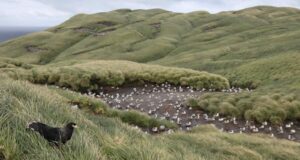
After leaving Diego Ramirez early on 21 February we travelled west over the continental shelf to Coburn Channel, then navigated through the fjords to Punta Arenas. Fortunately we were ahead of schedule for once, so entered the Channel in daylight, and were treated to some spectacular scenery. The birds over the shelf were quite different to those in oceanic waters farther south, with Sooty Shearwaters and Black-browed Albatrosses dominating. Once in the fjords, the albatrosses remained abundant, with large numbers sitting on the calm water like ducks.
| Sooty Shearwater | 369 | Black-browed Albatross | 298 |
| Imperial Shag | 98 | White-chinned Petrel | 30 |
| Kelp Gull | 19 | Southern Giant Petrel | 17 |
| Chilean Skua | 16 | Soft-plumaged Petrel | 15 |
| Magellanic Penguin | 8 | Brown-headed Gull | 7 |
| Southern Royal Albatross | 6 | Crested penguin spp. | 6 |
| Penguin spp. | 6 | Wilson’s Storm Petrel | 5 |
| Grey-headed Albatross | 4 | Magellanic Diving Petrel | 4 |
| Northern Giant Petrel | 3 | Dolphin Gull | 3 |
| Cape (Pintado) Petrel | 2 | Wandering Albatross | 2 |
| Northern Royal Albatross | 2 | South American Tern | 2
|
| Antarctic Fulmar | 1 | Shy Albatross | 1 |
Relatively few marine mammals were seen, but two new species were added to the trip list: several small pods of Peale’s Dolphins visited the ship, and an obliging group of five Sei Whales escorted us into Punta Arenas at sunrise on 22 February.
